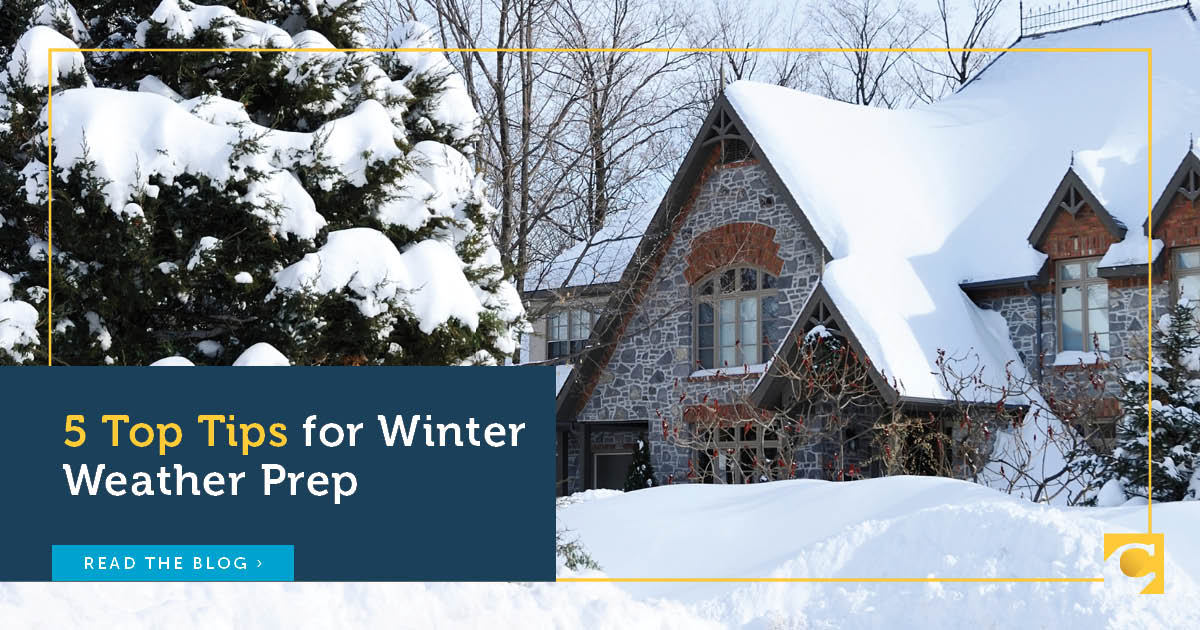5 Top Tips for Winter Weather Prep

Winter weather brings a slew of potential dangers for property owners. Whether you’re maintaining a commercial space or a home, preparing your space for the season can go a long way in protecting it.
In this article, the experts at Central offer five tips for keeping your buildings secure during snow, sleet, ice, and more.
Tip #1: Have a snow removal plan in place
Snow removal is a crucial aspect of winter weather preparation.
For homeowners who don’t have snow removal equipment or businesses without the maintenance staff to stay on top of snowfall, it’s important to set a snow removal plan in place before the season starts.
Get in touch with local contractors and set up a custom snow removal and maintenance plan that best fits your needs. For instance, if your property contains a long walkway, ensure the contractor is prepared to shovel the snow there. Similarly, consider investing in salt application services alongside generic plowing if your property is located up a steep driveway .
Next Step: How to Pick The Right Snow Removal Service
Tip #2: Prepare your thermostat settings
Maintaining proper temperatures in your home or office space is important for the comfort of your family or employees during winter weather, and for the protection of your home’s plumbing systems and pipes.
According to the Department of Energy & Environment, thermostats should be set to at least 68 degrees Fahrenheit during winter when a space is occupied. Whenever the space is not occupied (i.e. when a family is away on vacation or a company is off business hours), the temperature can drop to anywhere between 60 and 65 degrees Fahrenheit, but should never be kept lower or turned off completely.
Maintaining a 60-65 degree range can keep pipes from freezing and prevent water damage in your space.
Many newer homes and office spaces come with programmable thermostats that allow you to pre-schedule temperature shifts or make changes from your smartphone. However, older buildings will rely on manually lowering and raising the temperature. Make sure you figure out what type of thermostat your space has and plan before the temperatures outside drop.
Tip #3: Inspect internal spaces
Many property owners end up with a higher than average electricity bill in the winter due partly to the increased use of heat. Keep costs low and protect your building’s interior from external factors like snow and wind by doing a thorough inspection of the inside of your property before winter.
Look for cracks in the walls and loose windows or window frames that might let out warm air and let in the elements. Also, check the building’s insulation and ensure there aren’t holes that could lead to additional heat loss.
Tip #4: Do a roof check
Snow that piles up on your roof can cause lasting damage to your property. Luckily, there are steps you can take now to prevent this.
Despite its fluffy composition, snow itself is a dense material. While factors contribute to the weight of each snowfall (such as the wetness of the snow and even the shape of the snowflakes), the average one inch of snowfall equates to approximately one pound per square foot. That means a 2,000 sq. ft. roof with 3 inches of snow ends up holding roughly 6,000 lbs.
Roofs that aren’t properly maintained or have suffered external damage to supports, shingles, etc. are more likely to collapse under this extreme pressure. For that reason, you should audit your building’s roof prior to the first snowfall and make sure it’s prepared to withstand the weight of a heavy snowfall.
Tip #5: Stay on top of ice dams
Although most common in northern states, ice dams can be a detriment to home and business owners during the winter months.
Ice dams occur when dense snow collects on a roof, melts during warmer daylight hours, and then refreezes when it gets colder again at night. This cycle can carry on for multiple days, resulting in a build-up of melted water under shingles on the roof. Most often this water will leak through attics, ceilings, and walls, damaging not only the structure of the building but also the contents.
To prevent ice dams, the National Weather Service recommends cleaning out all leaves, sticks, and debris from gutters and downspouts prior to the first snowfall and then keeping snow buildup to a minimum once it begins. Roof rakes, which are long-handled scoops designed specifically for helping clear snow and prevent ice dams, are available for purchase online and in stores and work well in clearing hard-to-reach spaces.
Bonus Tip #6: Get your insurance policy in place
Sometimes, despite taking all the proper precautions, damage to your property still occurs in winter weather. In these cases, a solid homeowners or commercial property policy can protect you from extensive out-of-pocket costs for repairs.
Did You Know: According to The Insurance Information Institute, in the first few months of 2021 alone, over $15.1 billion reported in insured losses.
Reputable homeowners insurance like Central’s Signature Homeowners Policy is designed to provide the coverage you need to ensure your home is fully protected. It includes benefits such as full replacement cost coverage for rebuilding a home (even if the cost to rebuild exceeds the policy limit), replacement cost coverage (for damaged personal belongings), replacement cost loss settlement coverage (which is paid up front before repairs and replacements are complete), and much more.
>> Explore Central’s Homeowners Policy
Similarly, Central offers exceptional Commercial Property insurance coverage to protect businesses against these kinds of weather-related damages. Central’s Covered Property policies include protection for buildings and their contents, and our Covered Losses policies cover the loss of business due to damage to your building.
>> Explore Central’s Commercial Property Policy
Follow these tips for protecting your property and get your insurance policy set up today.
Like this:
Loading…







